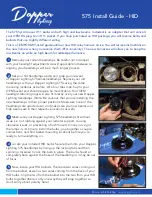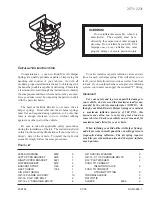
COMFORT ADJUSTMENT
125
In a severe frontal impact, the front airbag sensors detect
deceleration and the system triggers the front airbag inflators.
In a severe side impact, the side and curtain shield airbag
sensor and/or the curtain shield airbag sensor trigger(s) the
side and curtain shield airbag inflators and/or the curtain shield
airbag inflator. At this time, a chemical reaction in the inflators
quickly fills the airbags with non
−
toxic gas to help restrain the
forward or lateral motion of the occupants.
When the SRS airbag operates, it produces a fairly loud noise
and release some smoke and residue along with non
−
toxic
gas. This does not indicate a fire. This gas is normally
harmless; however, for those who have delicate skin, it may
cause a minor skin irritation. Be sure to wash off any residue
as soon as possible to prevent any potential skin irritation.
Deployment of the airbags happens in a fraction of a second,
so the airbags must inflate with considerable force. While the
system is designed to reduce serious injuries, it may also
cause minor burns or abrasions and swelling.
Parts of the airbag module (steering wheel hub, dashboard,
front seats, parts of the front and rear pillars and roof side) may
be hot for several minutes, but the airbags themselves will not
be hot. The airbags are designed to inflate only once.
A crash severe enough to inflate the driver and front passenger
airbags may break the windshield as the vehicle buckles. In
vehicles with a front passenger airbag, the windshield may
also be damaged by absorbing some of the force of the
inflating airbag.
CAUTION
D
The SRS airbag system is designed only as a
supplement to the primary protection of the driver
side and front and rear outside passenger side seat
belt systems. The front and rear outside seat
occupants can be killed or seriously injured by the
inflating airbags if they do not wear the available seat
belts properly. During sudden braking just before a
collision, an unrestrained driver, front passenger or
rear outside passenger can move forward or
sideways into direct contact with or close proximity
to the airbag which may then deploy during the
collision. To ensure maximum protection in an
accident, the driver and all passengers in the vehicle
must wear their seat belts properly. Wearing a seat
belt properly during an accident reduces the chances
of death or serious injury or being thrown out of the
vehicle. For instructions and precautions
concerning the seat belt system, see “Seat belts” on
page 108.
Summary of Contents for ES300 2003
Page 6: ...PICTORIAL INDEX v INSTRUMENT PANEL...
Page 8: ...PICTORIAL INDEX vii INSTRUMENT CLUSTER vehicles sold in U S A...
Page 10: ...PICTORIAL INDEX ix INSTRUMENT CLUSTER vehicles sold in Canada...
Page 14: ...PICTORIAL INDEX xiii...
Page 22: ...QUICK REFERENCE 8...
Page 60: ...SWITCHES 46...
Page 76: ...Finish GAUGES METERS AND SERVICE REMINDER INDICATORS 62...
Page 96: ...Finish INTERIOR EQUIPMENT 82...
Page 168: ...COMFORT ADJUSTMENT 154...
Page 174: ...AIR CONDITIONING 160 AUTOMATIC AIR CONDITIONING CONTROLS 20E283...
Page 176: ...AIR CONDITIONING 162 20E395 Air flow selection...
Page 234: ...AUDIO 220...
Page 262: ...STARTING AND DRIVING 248...
Page 276: ...DRIVING TIPS 262...
Page 300: ...IN CASE OF AN EMERGENCY 286...
Page 308: ...MAINTENANCE 294...
Page 316: ...INTRODUCTION 302 Make sure to place the jack correctly or your vehicle may be damaged...
Page 317: ...INTRODUCTION 303...
Page 347: ...CHASSIS 333...
Page 350: ...ELECTRICAL COMPONENTS 336 64E101 2 Engine compartment 64E102 3 Driver s side instrument panel...
















































